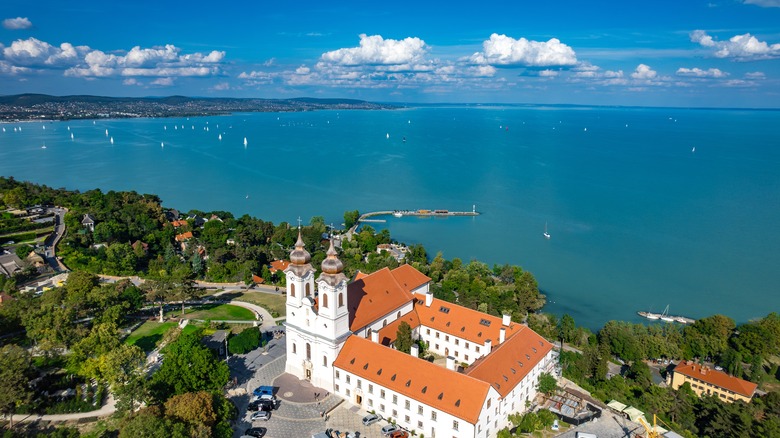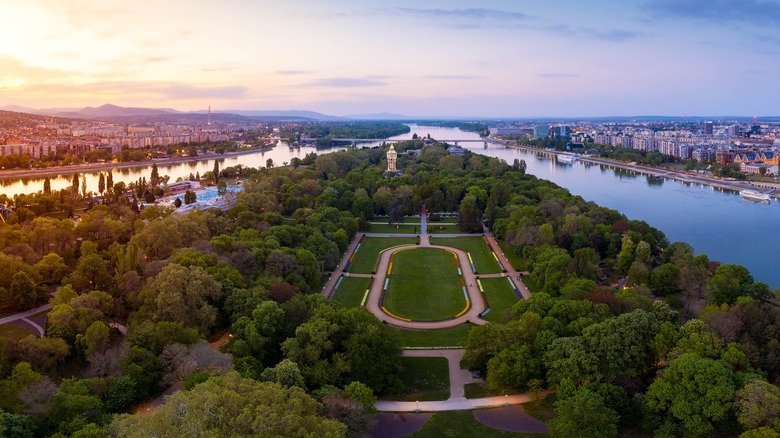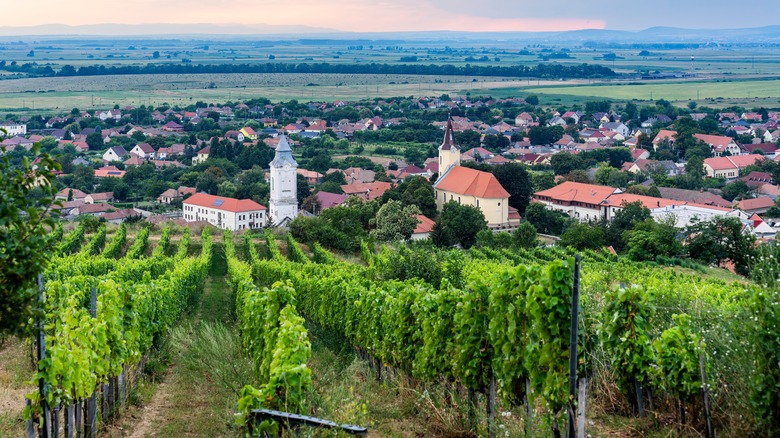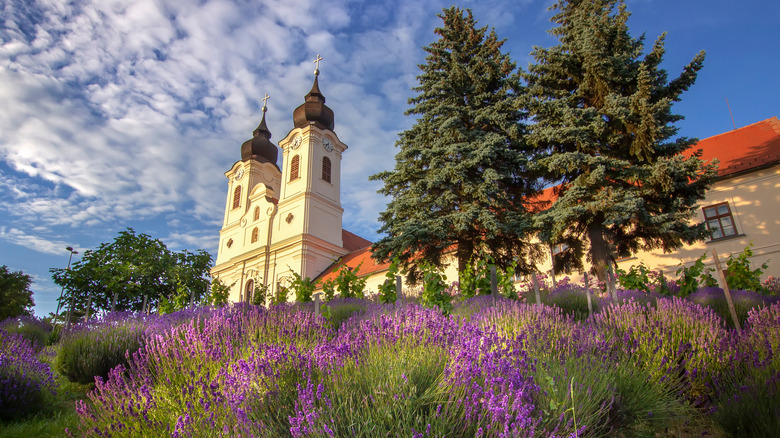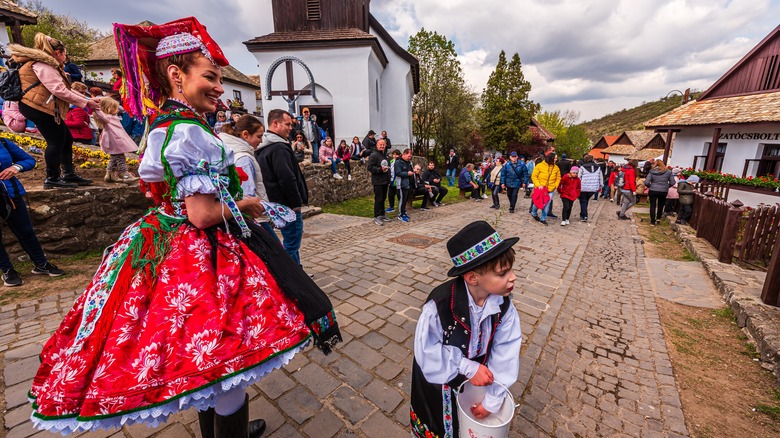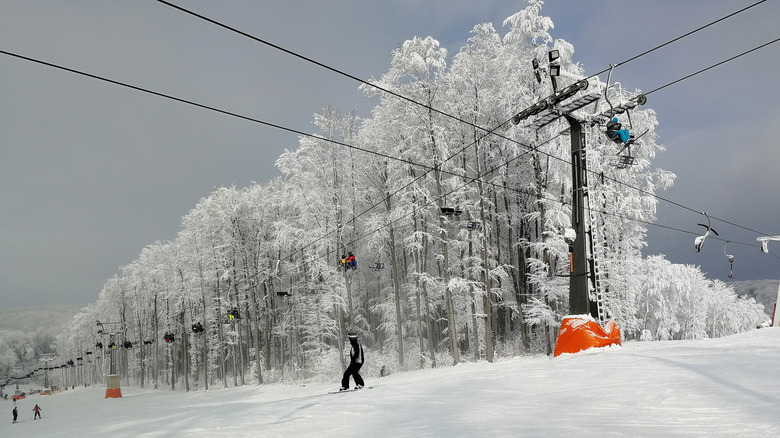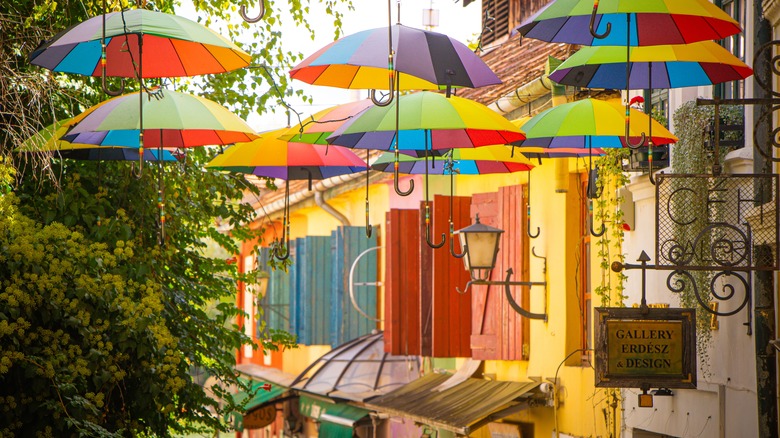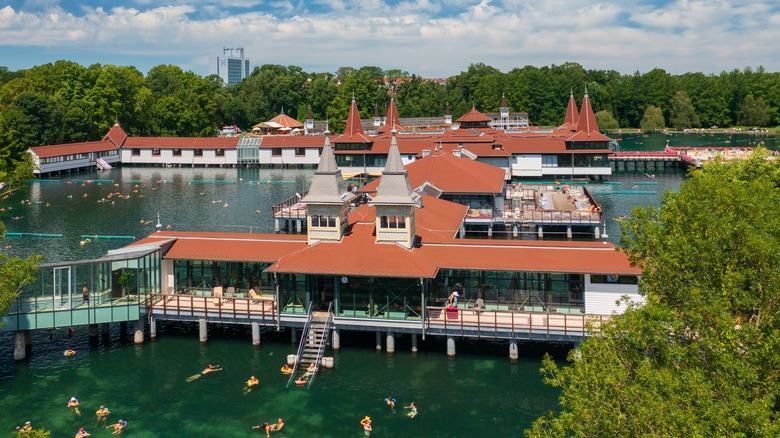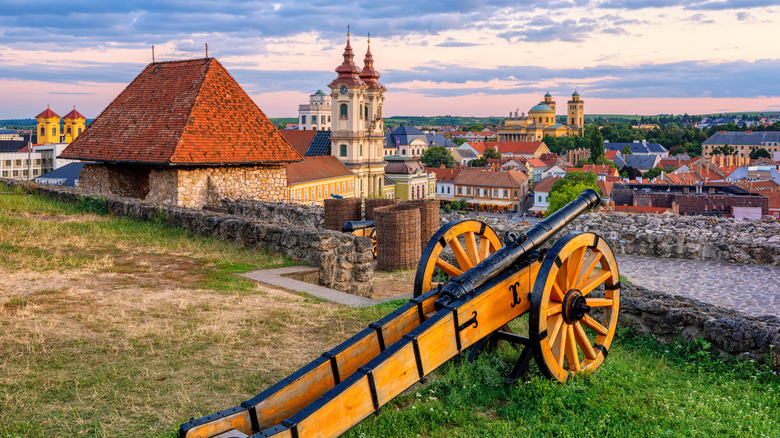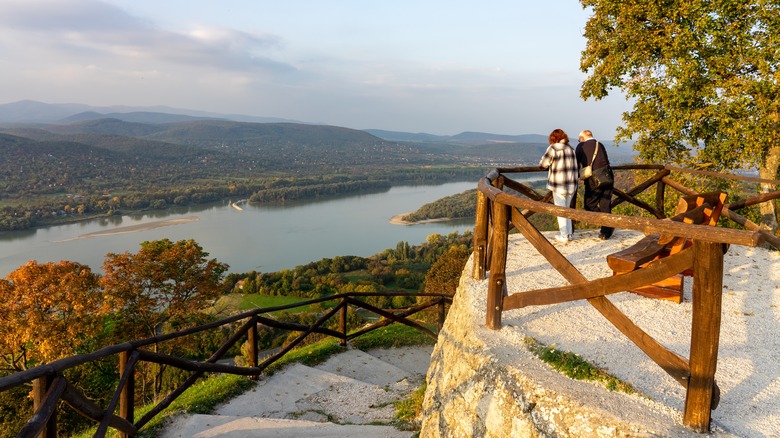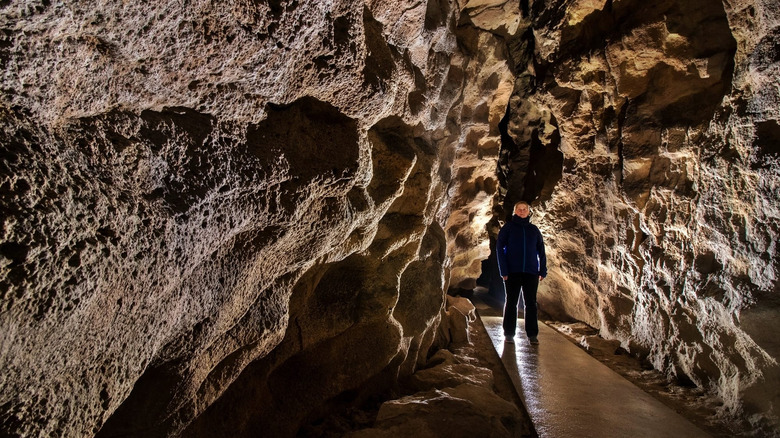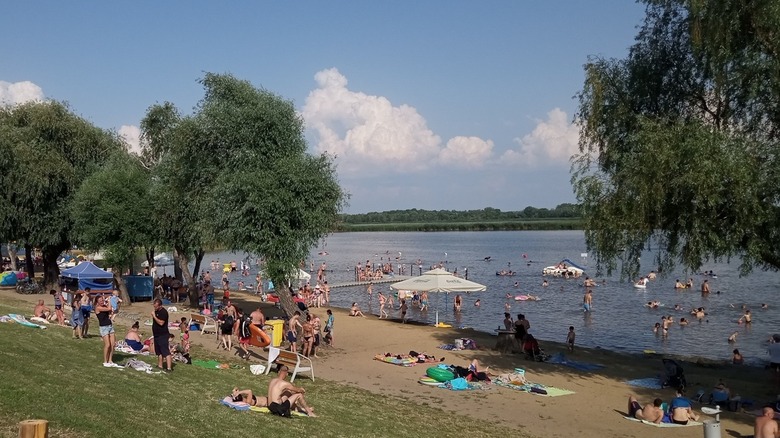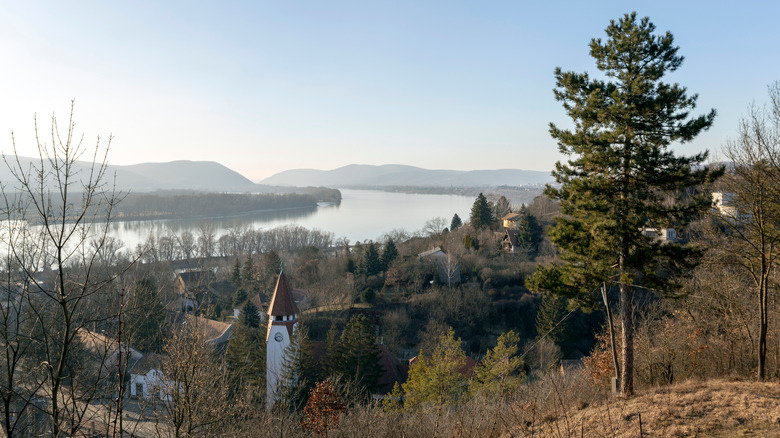The Best Hidden Gem Destinations In All Of Hungary
Budapest is called "the pearl of the Danube" for good reason. The magnificent river runs directly amid several landmarks of this Magyar metropolis, like the spired parliament building designed with Gothic grandeur, the hilltop Buda Castle, and the stone-hewn Chain Bridge suspended serenely between it all. These impressive sights and many more explain why Hungary's supreme city is the primary destination for global visitors in this nation at the heart of Europe.
But while Budapest's refined riverscape and awe-inspiring architecture make it one of the top cities to visit if you love Paris, Hungary's myriad charms can also be found outside of its capital. From the vineyard-covered hills in the country's northeast to the shimmering waters of sprawling Lake Balaton, many unique locales await visitors who like to venture off the beaten path. Moreover, countless sightseers in Budapest miss lesser-known attractions that are easily explored within city limits, often only enjoyed by locals.
Based on experiences from years of living in Budapest as an American expat, this article highlights Hungary's most spectacular sights that travelers frequently overlook. Along with historic monuments and natural wonders, we'll visit world-class wine regions, sporty recreation zones, and soothing hot springs offering something for everyone. Read on to discover the hidden gems of Hungary.
Margaret Island in Budapest
Right in the heart of Hungary's capital, an oasis of verdant parkland spreads across hundreds of acres amid the Danube River. Margaret Island is a cherished playground for all ages, featuring lush flower beds that line curvaceous walking paths and tree-shaded meadows perfect for picnics. But this is no ordinary green space offering simple respite from surrounding city streets — numerous establishments here welcome the public for delightful diversions, ranging from a major entertainment venue to grand Budapest hotels offering relaxing wellness facilities.
During summertime, the massive Margaret Island Theater is Budapest's premier spot for open-air opera performances and jazz concerts. Alfresco eateries provide satisfying meals and potent potables to savor while watching riverboats slowly drift by. And, two full-service resorts are connected to a modern spa featuring pools of Hungary's renowned thermal waters.
Plenty of free attractions await around Margaret Island, too. A well-maintained Japanese Garden provides a serene spot for peaceful reflection by its lilypad-dotted pond occupied by koi fish, while the stone ruins of a 13th-century convent present a historical perspective on this isle once explored by ancient Romans. Here you'll also find Hungary's biggest musical fountain, where fanciful streams of water dance in sync to amplified tunes, all enhanced by a colorful light show. An entire vacation could be spent on this easygoing island without even realizing that you're in the middle of a major metropolis.
Tokaj wine region
About 15 million years ago, the land that is now Hungary's renowned Tokaj wine region became a hotbed of volcanic eruptions, filling the soil with mineral-rich rocks that now feed the world-class vineyards crisscrossing this part of the country's northeastern corner. Wine has been made here for centuries, and since the 1600s Tokaj remains widely renowned for a special sweet variety called aszú, which can only be produced in this unique microclimate. Historic fans of aszú are said to include King Louis XIV of France, Ludwig van Beethoven, and Britain's Queen Victoria.
The value of these vineyards was made official in 1757 when Tokaj was designated as the world's first wine appellation, long before similar terroir-classification systems were established in France or Italy. In recognition of this rich viticultural history, the entire region surrounding the town of Tokaj was granted Unesco World Heritage status in 2002. Nowadays Tokaj's labyrinthine wine cellars and serene grape-growing terrain attract a steady stream of international connoisseurs — who can also savor sips of outstanding local dry whites like furmint and muscat. Beyond wine tourism, this area features forested hills ideal for cycling and hiking, and excellent restaurants serving modern Hungarian cuisine. This is a perfect place to add to your bucket list of little-known European destinations for food lovers.
Tihany at Lake Balaton
Central Europe's largest lake is in Hungary, and with nearly 150 miles of picturesque shoreline, this is the country's most popular domestic tourism destination, now becoming increasingly discovered by international visitors as well. There are plenty of welcoming places to enjoy around Lake Balaton, from the hilly wine-country communities of the north coast to the family-friendly strands on the southern side. But in the middle of it all, a dramatic peninsula hosts the historic town of Tihany, a uniquely stunning destination often admired only from afar.
The charms of Tihany are many but one of its most famous is the Benedictine Abbey, with its foundation dating back nearly a millennium. Today the abbey's twin steeples serve as an iconic lakeside landmark, and sightseers can tour the stately Baroque church of this still-functioning religious monument, featuring impressive ceiling frescoes, ornate wood carvings, and a pipe organ topped with angel statues. Besides the abbey, there's a lengthy walkway where visitors can enjoy far-reaching vistas over Balaton's azure waters and gliding sailboats.
But there are myriad other enjoyable draws around Tihany, including a particularly pleasant aromatic attraction. For about a century now, this is Hungary's preeminent site for growing lavender, and a summertime stroll around the peninsula will feature views of purple fields covered with these fragrant flowers. Several shops around Tihany offer diverse lavender-infused products ranging from soap to syrup to gin.
Hollókő
Hollókő is a Hungarian village set in time, showcasing European culture from a bygone era. Thanks to the dedicated efforts of Hollókő's residents, carefully preserved rural houses appear almost unchanged from the late 1800s, lining cobblestone streets that surround a simple but splendid wooden-steepled church. This is the community's centerpiece for varied celebrations featuring locals wearing floral-embroidered finery from Hungary's past, enjoying traditional customs in the same style as their ancestors.
Hollókő especially comes alive during its annual Easter festivities. Along with admiring spirited performances of folk dancing and singing, visitors are welcome to observe a time-honored Hungarian ritual of this springtime holiday, when boys chase girls with buckets of water and douse them mercilessly. Other old-fashioned events drawing curious crowds include Pentecost proceedings and a summertime raspberry festival — but several museums, handicraft shops, and restaurants are regularly open to the public.
Another fascinating relic of Hollókő is its imposing medieval castle sited on a nearby hilltop, with its gray stone walls dating back to the 13th century. Following a thorough restoration, this crenelated landmark now appears as it must've to the many marauders who passed through this region throughout European history. Thankfully, this place is peaceful nowadays, and the castle grounds offer panoramic views over the forested Cserhát Hills of northern Hungary.
Eplény
Hungary doesn't have much for mountains; its tallest peak is little more than a half-mile high. Because of this, skiers and snowboarders often opt out of Hungary to instead explore the more impressive slopes of nearby Austria — or even Bosnia and Herzegovina, Europe's underrated mountainous gem. However, a forested town north of Lake Balaton provides Magyars with a pleasant domestic alternative for a snowy activity.
The ski resort at Eplény may never host the Winter Olympics, but for anyone seeking an easygoing weekend of frosty fun, it's well worth the hour-and-a-half drive from Budapest. Served by a total of nine lifts, Eplény offers close to five miles of slopes that are mostly easy, but a few startlingly steep runs are definitely best left to extreme athletes. Overall, this is a perfect destination for families or groups whose members have varying skill levels. Adding to the diagonal excitement, during summertime Eplény transforms its slopes into downhill mountain biking runs, with one chairlift equipped to carry bikes alongside passengers.
Szentendre
Take a short day trip from Budapest to the rustic riverfront town of Szentendre, a longtime haven for artists. Reachable from Hungary's capital by a panoramic ferryboat ride on the Danube or by taking the commuter train that departs from Budapest's Batthyány Square, Szentendre's winding hillside streets lead to charming churches, intriguing museums, and numerous cafes perfect for scribbling, sketching, and people-watching. While this town certainly has its share of tourists and schlocky souvenir shops, looking beyond the main streets will lead you to galleries and boutiques that present genuine innovations by modern Magyar creatives.
Some of the most interesting art displays to see here include the Margit Kovács Ceramic Museum — featuring hundreds of diverse sculptures and pottery pieces — and the Ferenczy Museum, occupying a resplendent villa that showcases both 20th-century luminaries and contemporary visionaries. Climb uphill to the Saint John the Baptist Catholic Parish Church, where you can admire Bible-inspired frescoes painted by local artists, as well as enjoy views from the surrounding square that stretch over the community's red-tiled roofs. For a peek into Szentendre's present-day scene, seek out Folt, a hip hangout with artwork by up-and-coming artists and open-air concerts in the evenings.
Hévíz thermal lake
Beneath Hungary's surface, mineral-rich waters constantly bubble upwards. These hot springs fill pools at the historic thermal baths of Budapest and nationwide, and a dunk in these spas is a must-do. However, Lake Hévíz is in a category of its own — this is one of the world's largest natural bodies of thermal water that swimmers can safely submerge in.
Found a short distance west of Lake Balaton, Lake Hévíz has a surface of around 11 acres and is approximately 125 feet deep — but every three days, all of the lake's water is completely replenished by a gushing hot spring below. The thermal water is rich with rejuvenating minerals known to provide relief for a variety of physical ailments, which is why the Hungarian bathing culture dates back centuries. While evidence indicates that ancient Romans were swimming in Lake Hévíz, the first dedicated bathing facilities were built here in 1795.
Today a sprawling wellness complex is constructed directly above the water's surface, providing visitors with pools, saunas, and other health-boosting amenities available year-round; the water temperature rarely dips below 75 degrees Fahrenheit, even in the depths of winter. A layer of mist that blankets the lake's surface even gives swimmers allergy relief, as the steam dissolves airborne pollen. Surrounded by forests and ample accommodations in the adjacent town, Lake Hévíz provides a natural haven, as evidenced by the flora and fauna thriving here.
Eger
Nestled in Hungary's northern highlands, Eger is an intriguing city that encapsulates much of the country's volatile history with its diverse mix of architecture and attractions. As the Ottoman Empire expanded its incursion into Central Europe during the mid-1500s, the Castle of Eger was besieged by its invading army that vastly outnumbered the Hungarian defenders. However, under the leadership of military genius István Dobó, the Magyars managed to repel their attackers, and this underdog triumph remains a major point of pride nationwide.
Nowadays Eger's castle is an expansive museum that frequently hosts historic reenactments, while Dobó Square features a statue of its namesake hero; this is where locals gather at sidewalk cafes amid a lively scene at the city's heart. Here the Minorite Church ranks among Europe's finest examples of Baroque architecture, while just steps away, Eger's unusually central thermal spa welcomes the public with 13 pools. Alas, because the Ottomans eventually conquered Eger in 1596 and remained for over 90 years, the occupiers left cultural traces still visible citywide, including the Turkish Bath at the aforementioned spa and a still-standing minaret reaching some 130 feet tall.
The post office here is historic, as well — it's been operating continually since 1550. However, more modern draws of Eger include Central Europe's sole Beatles Museum and an underpass where graffiti artists are encouraged to express their creativity. While visiting, wine aficionados won't want to miss out on a glass of Eger's specialty, the bold red called bikavér.
Danube Bend
Before reaching Budapest, the Danube River flows through some of Hungary's prettiest scenery. The meandering stretch of waterway connecting the northern town of Esztergom with Hungary's capital is called the Danube Bend, and this region is lined with dramatic hills, quaint villages, and one of the country's most striking castles. With all of these sights, this riparian setting is considered a highlight of Europe's best romantic cruises on the Danube River.
Traveling from north to south, the stunning views begin with Hungary's biggest church, Esztergom Basilica, noted for its towering green dome. Next, the Danube bends and winds between green mini-mountains fronted by serene settlements on the water's edge before reaching Visegrád, home to an imposing hilltop castle rich with Hungarian history. From its strategically crucial vantage point, this medieval landmark has been a key setting for much of the country's tumultuous past; it's even believed that Vlad the Impaler — the bloodthirsty inspiration for Dracula — was imprisoned here for years during the 15th century.
The remainder of the ride along the Danube Bend to Budapest is also superbly scenic, and one-day river cruises between the Magyar metropolis and Esztergom are available. However, if you can explore this region by car or bike, it's well worthwhile. In addition to being able to take your time exploring Visegrád's castle, this also allows you to visit enchanting towns along the riverbanks, including the hiker's paradise of Zebegény and the artists' retreat of Verőce.
Caves beneath Budapest
While enjoying the urban excitement of central Budapest, many visitors never realize that directly below them, people are exploring amazing underground scenes. The same hot springs that fill the city's thermal baths have also carved scores of extensive cave systems deep beneath Hungary's capital, and several of these caverns welcome visitors for experiences ranging from easygoing excursions to challenging spelunking adventures. In addition to fascinating geological formations, sightseers can discover some caves that have played key roles in Budapest history, and today serve as captivating museums.
Tucked within the Buda Hills, the natural Pál-völgyi Cave system stretches for many miles, and an easily accessible section of it welcomes almost anyone to admire its dripstones and fossils — but more hard-core sightseers can strap on a lamp-equipped helmet and join subterranean excursions deep into the caverns, traversing several stretches that require squeezing through truly tight spots. Meanwhile, directly below the Buda Castle, the Labyrinth is a creepy network of caves expanded during medieval times to serve as a dungeon, where skulls and bones are still visible today for anyone brave enough to take a tour. Not far away, the Hospital in the Rock is another cavern system that was extensively developed to serve as a medical shelter during World War II, before Hungary's Soviet occupiers transformed it into a Cold War nuclear bunker; now it's a museum that highlights Budapest's harrowing 20th-century history.
Lake Tisza
Often overlooked even by Hungarians, Lake Tisza is not as big or geographically blessed as Lake Balaton. This segmented man-made reservoir didn't even exist before the 1970s when a dam was completed on the Tisza River amid the country's eastern plains. However, Hungary's second-largest lake is an underrated recreation zone that deserves to be discovered for sporty getaways or lazy days.
Several full-service swimming areas provide family-friendly facilities for making a splash, while ample river fish ensure that this lake is a popular destination for anglers. Lake Tisza may also rival some of the best bird-watching destinations in the U.S. — here visitors can observe herons, eagles, ospreys, and many more of the lake's majestic avian inhabitants amid a protected section of Tiszavalk Bay. Further exploration of the 20-mile-long lake can be carried out aboard rented canoes or motorboats, allowing possible close encounters with otters and beavers.
The shoreline itself offers many attractions, including campgrounds, a freshwater aquarium, and a petting zoo. But, visitors can also explore the paved cycling paths that encircle the entire lake, with the largest circuit stretching almost 60 miles. Rent a bicycle and must-have biking gear in the town of Tiszafüred and take your time discovering this uncrowded rural idyll, stopping at eateries or watering holes that pique your interest.
Methodology
This article was based on firsthand memories of visiting every spot recommended here over more than a decade living as an American expat in Hungary. Thanks to employment as an editor for multiple Budapest-based media outlets, some of the featured establishments provided free entry for writing previous articles — but most of these places were discovered as an independent traveler. Beyond personal recollections, official destination websites and other trusted online sources were referred to when checking for up-to-date information and background details utilized for research on this feature.
